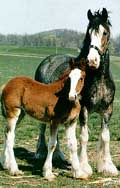Clydesdale
N/A
Fri, 4th April, 2025 - 4:10 pm GMT
Sponsor Ads:

Alternative Name
N/ABasic Info
The outstanding characteristics of this renowned horse are a combination of weight, size and activity, and what is looked for first and last by a Clydesdale enthusiast is the exceptional wearing qualities of feet and limbs. The feet must be round and open with hoof heads wide and springy, for any suspicion of contraction might lead to sidebones or ringbones. To some extent, the further requirements of this breed vary somewhat from the orthodox and should be noted. The horse must have action, but not exaggerated, the inside of every shoe being made visible to anyone walking behind. The forelegs must be well under the shoulders, not carried bull-dog fashion, in fact must hang straight from shoulder to fetlock joint, with no openness at the knee, yet with no inclination to knock. The hind legs must be similar, with the points of the hocks turned inwards rather than outwards, and the pasterns must be long. Distinctive long, silky hair below the knees and hocks draw attention to the stylish lifting of the feet at the trot. The head must have an open forehead, broad across the eyes, the front of the face must be flat, neither dished nor roman, wide muzzle, large nostrils and a bright, clear, intelligent eye. A well-arched and long neck must spring out of an oblique shoulder with high withers, while the back should be short, with well-sprung ribs, and, as befits a draught horse, the thighs must be packed with muscle and sinew. The most common colors in the Clydesdale breed are bay, black and brown. Roans (solid body color with white hairs throughout the coat) are also seen with some occasional chestnuts. White is seen on the face and legs with white often running into the body. The show ring does not discriminate on color with light roans and horses with dark legs being considered equally with horses of the more solid colors and traditional markings.
Health
N/AHabitat
N/ABehavior
It is claimed of the Clydesdale that they are possessed of quality and weight without displaying grossness and bulk, this is largely true. They are certainly active movers for their size and weight, and in consequence, are very popular in many cities and on numerous farms..Origin
ScotlandHistory
The Clydesdale is a breed of heavy draft horse developed in and deriving its name from the district in Scotland where it was founded. Its type was evolved by the farmers of Lanarkshire, through which the River Clyde flows. The old name for Lanarkshire was Clydesdale. It was bred to meet not only the agricultural needs of these farmers, but the demands of commerce for the coalfields of Lanarkshire and for all types of heavy haulage on the streets of Glasgow. The breed thus developed and soon acquired more than a local reputation. In time, the breed spread throughout the whole of Scotland and northern England. The district system of hiring stallions was an early feature of Scottish agriculture and did much to standardize and fix the type of the breed. The records of these hiring societies go back in some cases to 1837. The Clydesdale Horse Society was formed in 1877 and has been an active force in promoting the breed not only in Great Britian but throughout the world. The Clydesdale Breeders of the United States is the member organization for the Clydesdale horse. The Association was incorporated on December 4, 1879 as the American Clydesdale Association with members from both the United States and Canada. The first volume of the stud book was ready for distribution at the fourth Annual Meeting in the fall of 1882. The Clydesdale alone, of the British breeds of heavy draft, has enjoyed a steady export trade to all parts of the world. The most active trade has been to commonwealth countries and the United States. The Clydesdale remains popular, though not a numerical leader in Canada and the United States.Common Foods
grassSponsor Ads:
When there are two conflicting versions of the story, the wise course is to believe the one in which people appear at their worst. --H. Allen Smith
Clydesdale
Coded by: BGID® | ALL RIGHTS RESERVED Copyright © 2000-2025
Disclaimer | Privacy | Report Errors / Contact | Credits








 Preparing For China. China is growing their military. China Military Technology - can it keep up with the US?
Preparing For China. China is growing their military. China Military Technology - can it keep up with the US?  versus
versus 

 versus
versus 
 This Thread is about the North Korean Military itself - the kind of army, navy, and air force they have.
This Thread is about the North Korean Military itself - the kind of army, navy, and air force they have. 
 versus
versus 
 versus
versus  versus
versus